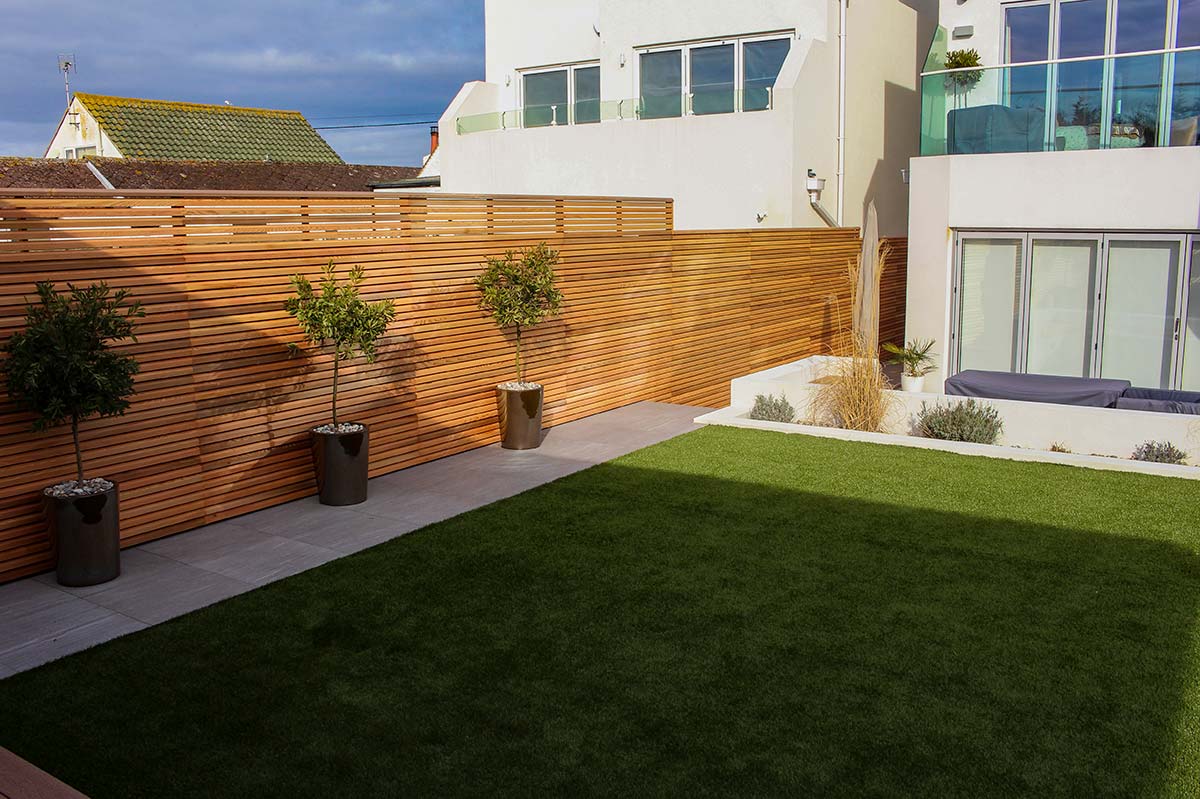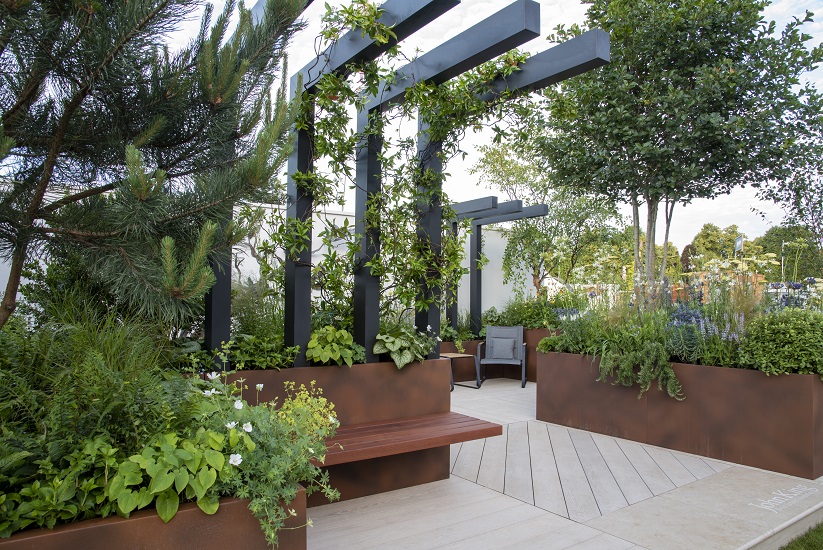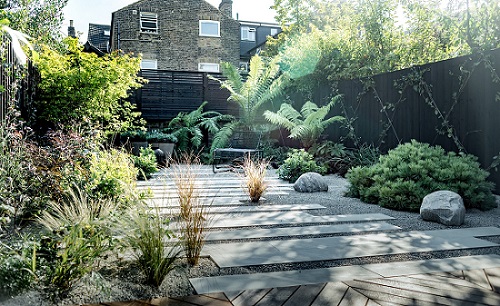Scottish garden designer Tracy McQue talks us through how to make a narrow garden look wider with some clever design wrinkles.
“I wanted the owner to get to the bottom of the garden without feeling he'd gone down a straight path.” This was the challenge designer Tracy McQue set herself when faced with a long, narrow garden in Arbroath on the east coast of Scotland. Not only that, but high walls on either side emphasised its narrow length.
What would you have done? Tracy's answer was to take several design elements and cunningly combine them.
Picture courtesy of Tracy McQue.
Use colour to break up the space
First, Tracy chose highly differentiated paving. Jettisoning her first choice of Silver Grey and Blue Grey Granite because she feared they wouldn't show enough of a contrast when wet (a frequent occurrence – this is Scotland we're talking about), she briefly considered Contemporary Grey Sandstone before finally plumping for the lighter coloured Heath sawn sandstone in combination with the much darker Black Basalt. Also in the mix is wooden decking in larch (which will quickly silver to blend with the sandstone) and grey gravel.
What these materials give is, says Tracy, “Plenty of contrast with good definition.” Thus the space is broken up, creating a sense of different “rooms” without losing the sense of space.
Heath sandstone and black basalt, laid by Boxelder Landscapes. Picture courtesy of Boxelder Landscapes.
Lead the eye
She also employed sets of three – the three pads of stone paving, the three areas of larch, which is used for the seating and table as well as decking, three areas of gravel (one in the base of the ripple-free pond, one next to the back wall of the house). This introduces a relaxed, informal feeling, which encourages the eye to move freely around the space.
Even the staircase railings join in, echoing the two larch screens. The railings were originally painted marine blue to match decoration in the house. “It was too distracting,” says Tracy, “and we persuaded them to paint them darker. This is an industrial part of Arbroath and you can't ignore the setting.” The darker colour helps make them a part of the design, rather than merely the access to it.
The garden before the build. As an old smokehouse yard, it had originally been filled with outbuildings. Stuart Ralph of Boxelder Landscapes, who often works with Tracy, had to break up ten inches of solid concrete beneath the surface before starting the build.
Use triangles
Look closely and it becomes clear that Tracy used, as an element of her design, another “three”—a triangle between the morning and evening seating areas. The pond forms two sides of a right-angled triangle, and the triangle's opposite, sloping side forms the majority of the main path to the end of the garden. This means that, as you cross the paving, your eye is taken along the base of the triangle to the right side, again reducing the impression of a straight path.
Behind the right angle of the triangle a large shrub echoes what will become a large shrub at the diagonally opposite corner between the screen and the stairs. “The eye bounces from one to the other,” says Tracy. This maximises the sense of distance between one side of the garden and balances the direction of the paving.
Without the larch screen, you'd see straight down the garden as you descended the staircase. Picture courtesy of Tracy Mcque.
It didn't all go according to plan. Early on, the high sandstone wall on the left, heavily pitted by the salt air, was discovered to be in a dangerous state, so a breeze-block wall was built alongside, meaning that 30-40 cms was lost from the width of the garden. “The water isn't so big on the left as it would have been,” says Tracy, who feels the loss. Here, though, is another subtle break in the journey down the garden, where the water gap interrupts the paving.
View from above, showing the basalt coping on the double thickness wall.. Picture courtesy of Boxelder Landscapes.
Create level changes
Finally, there are plenty of changes in level—from decking to paving, from paving to gravel. Even the lower level in the gravel pond is visible, because the ripple-free water is kept clear with UV filters and copper dosing.
Different heights and textures tempt the eye to look around. Photo: Tracy McQue.
Rising, we have the raised beds and the table that prevents a direct path across the paving. From above, Black Basalt Coping on top of the boundary walls links them with the raised beds below and helps assimilate the similarly coloured slate roofs into the overall design, while the larch screens offer an intermediate step from high to low. All these changes encourage the eye to move up and down and around the garden and pause on detail, rather than looking straight down to the end.
What the client thought
The client had asked for a contemporary garden with an exotic theme which he could enjoy when back on his annual visit from the Philippines, but which also provided interest for his downstairs tenant, Charlie, who is a keen gardener and had originally introduced a Japanese feel to the space with lots of foliage.
“It was very masculine,” says Tracy. “No flowers. We wanted an evergreen structure but left spaces for Charlie to plant things in pots, and added flowers, like dark purple iris.” She's also also included an amelanchier, Cherry 'Stella' compact, a Magnolia stellata, and an espalliered Discovery apple.
Planting has an evergreen structure with a Japanese touch and subtle colour. Picture courtesy of Boxelder Landscapes.
And the good and bad point about the project? “The client was in the Philippines,” says Tracy. “He agreed the design but didn't want any photos. When he came back it was like some ghastly Ground Force reveal. Nerve-racking.”
She needn't have worried, though. He really liked it, so much that he's thinking of coming back twice in the year to enjoy the garden in spring.
Tracy certainly disguised the straight track down to the end of the garden, but she couldn't have had a more straight-forward expression of approval than that.
Design Tip: add texture to paving with pebbles and chippings
Post updated: November 2024


/filters:quality(40)/mediadev/media/homepage/price_right_arrow.svg)
/filters:quality(60)/mediadev/media/menu-pics/menu_banner_mobile.png )
/filters:quality(60)/mediadev/media/menu-pics/all-porcelain.jpg )
/filters:quality(60)/mediadev/media/menu-pics/luxury-italian.jpg )
/filters:quality(60)/mediadev/media/menu-pics/premium-italian.jpg )
/filters:quality(60)/mediadev/media/menu-pics/budget-porcelain.jpg )
/filters:quality(60)/mediadev/media/menu-pics/large-format-porcelain.jpg )
/filters:quality(60)/mediadev/media/menu-pics/wood-effect-porcelain.jpg )
/filters:quality(60)/mediadev/media/menu-pics/porcelain-planks.jpg )
/filters:quality(60)/mediadev/media/menu-pics/porcelain-setts.jpg )
/filters:quality(60)/mediadev/media/menu-pics/browse-all-paving.jpg )
/filters:quality(60)/mediadev/media/menu-pics/stone-paving.jpg )
/filters:quality(60)/mediadev/media/menu-pics/interior-tiles.jpg )
/filters:quality(60)/mediadev/media/menu-pics/stone-effect-porcelain.png )
/filters:quality(60)/mediadev/media/menu-pics/wood-effect-porcelain.png )
/filters:quality(60)/mediadev/media/menu-pics/grey-porcelain.png )
/filters:quality(60)/mediadev/media/menu-pics/beige-porcelain.png )
/filters:quality(60)/mediadev/media/menu-pics/dark-porcelain.png )
/filters:quality(60)/mediadev/media/menu-pics/light-porcelain.png )
/filters:quality(60)/mediadev/media/menu-pics/patio-grout.jpg)
/filters:quality(60)/mediadev/media/menu-pics/primers.jpg)
/filters:quality(60)/mediadev/media/menu-pics/porcelain-blades.jpg)
/filters:quality(90)/mediadev/media/menu-pics/drainage.jpg)
/filters:quality(60)/mediadev/media/menu-pics/cleaners.jpg)
/filters:quality(60)/mediadev/media/menu-pics/all-stone-paving.jpg )
/filters:quality(60)/mediadev/media/menu-pics/all-sawn-paving.jpg )
/filters:quality(60)/mediadev/media/menu-pics/all-riven-paving.jpg )
/filters:quality(60)/mediadev/media/menu-pics/indian-sandstone.jpg )
/filters:quality(60)/mediadev/media/menu-pics/limestone-paving.jpg )
/filters:quality(60)/mediadev/media/menu-pics/granite-paving.jpg )
/filters:quality(60)/mediadev/media/menu-pics/slate-paving.jpg )
/filters:quality(60)/mediadev/media/menu-pics/yorkstone-paving.jpg )
/filters:quality(60)/mediadev/media/menu-pics/stone-pavers.jpg )
/filters:quality(60)/mediadev/media/menu-pics/cobbles-setts.jpg )
/filters:quality(60)/mediadev/media/menu-pics/plank-paving.jpg )
/filters:quality(60)/mediadev/media/menu-pics/paving-circles.jpg )
/filters:quality(60)/mediadev/media/menu-pics/bespoke-paving-1.jpg )
/filters:quality(60)/mediadev/media/menu-pics/edging-stones-1.jpg )
/filters:quality(60)/mediadev/media/menu-pics/prestige-stone.jpg )
/filters:quality(60)/mediadev/media/menu-pics/grey-blue-stone.png)
/filters:quality(60)/mediadev/media/menu-pics/swatch-black-dark.jpg )
/filters:quality(60)/mediadev/media/menu-pics/swatch-buff-beige-white.jpg )
/filters:quality(60)/mediadev/media/menu-pics/sealants.jpg)
/filters:quality(60)/mediadev/media/menu-pics/all-clay-paving.jpg )
/filters:quality(60)/mediadev/media/menu-pics/alpha-clay-pavers.jpg )
/filters:quality(60)/mediadev/media/menu-pics/cottage-garden-clay-pavers.jpg )
/filters:quality(60)/mediadev/media/menu-pics/kessel-garden-clay-pavers.jpg )
/filters:quality(60)/mediadev/media/menu-pics/artisan-clay-pavers.jpg )
/filters:quality(60)/mediadev/media/menu-pics/grey-blue-clay-paver.png )
/filters:quality(60)/mediadev/media/menu-pics/red-brown-clay-pavers.png )
/filters:quality(60)/mediadev/media/menu-pics/beige-buff-clay-pavers.png )
/filters:quality(60)/mediadev/media/menu-pics/composite-decking.jpg )
/filters:quality(60)/mediadev/media/menu-pics/designboard-decking.jpg )
/filters:quality(60)/mediadev/media/menu-pics/classic-designboard.jpg )
/filters:quality(60)/mediadev/media/menu-pics/brushed-designboard.jpg )
/filters:quality(60)/mediadev/media/menu-pics/grooved-designboard.jpg )
/filters:quality(60)/mediadev/media/menu-pics/millboard-decking.jpg )
/filters:quality(60)/mediadev/media/menu-pics/grey-decking.jpg )
/filters:quality(60)/mediadev/media/menu-pics/black-charcoal-decking.jpg)
/filters:quality(60)/mediadev/media/menu-pics/brown-decking.jpg)
/filters:quality(60)/mediadev/media/menu-pics/all-build-deck.png )
/filters:quality(60)/mediadev/media/menu-pics/stone-cladding.jpg )
/filters:quality(60)/mediadev/media/menu-pics/all-garden-walling-1.jpg )
/filters:quality(60)/mediadev/media/menu-pics/facing-bricks.jpg )
/filters:quality(60)/mediadev/media/menu-pics/garden-screening.jpg )
/filters:quality(60)/mediadev/media/menu-pics/menu_Garden_banner_desk.png )
/filters:quality(60)/mediadev/media/menu-pics/all-steps-coping.jpg )
/filters:quality(60)/mediadev/media/menu-pics/stone-garden-steps.jpg )
/filters:quality(60)/mediadev/media/menu-pics/sawn-steps.jpg )
/filters:quality(60)/mediadev/media/menu-pics/riven-steps.jpg )
/filters:quality(60)/mediadev/media/menu-pics/yorkstone-steps.jpg )
/filters:quality(60)/mediadev/media/menu-pics/bespoke-steps.jpg )
/filters:quality(60)/mediadev/media/menu-pics/porcelain-steps.jpg )
/filters:quality(60)/mediadev/media/menu-pics/off-the-shelf.jpg )
/filters:quality(60)/mediadev/media/menu-pics/stone-coping.jpg )
/filters:quality(60)/mediadev/media/menu-pics/sawn-coping.jpg )
/filters:quality(60)/mediadev/media/menu-pics/riven-coping.jpg )
/filters:quality(60)/mediadev/media/menu-pics/yorkstone-coping.jpg )
/filters:quality(60)/mediadev/media/menu-pics/bespoke-coping.jpg )
/filters:quality(60)/mediadev/media/menu-pics/stone-pier-caps.jpg )
/filters:quality(60)/mediadev/media/menu-pics/porcelain-coping.jpg )
/filters:quality(60)/mediadev/media/menu-pics/all-bespoke-services.jpg )
/filters:quality(60)/mediadev/media/menu-pics/bespoke-paving-2.jpg )
/filters:quality(60)/mediadev/media/menu-pics/bespoke-steps-1.jpg )
/filters:quality(60)/mediadev/media/menu-pics/bespoke-coping-1.jpg )
/filters:quality(60)/mediadev/media/menu-pics/edge-profiles.jpg )
/filters:quality(60)/mediadev/media/menu-pics/masonry-services.jpg )
/filters:quality(60)/mediadev/media/menu-pics/deluxe-pergolas.jpg )
/filters:quality(60)/mediadev/media/menu-pics/proteus-pergolas.jpg )
/filters:quality(60)/mediadev/media/menu-pics/corten_planter_menu.png )
 Trade Discount Available
Trade Discount Available FREE Nationwide Delivery
FREE Nationwide Delivery Nationwide Showrooms
Nationwide Showrooms Live Stock Levels
Live Stock Levels Split Packs Available
Split Packs Available








